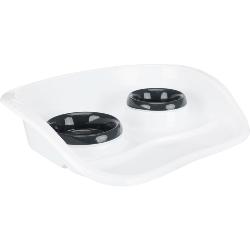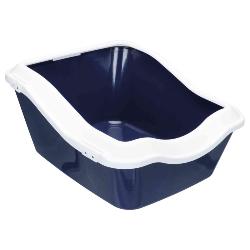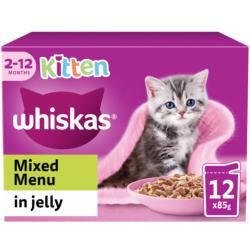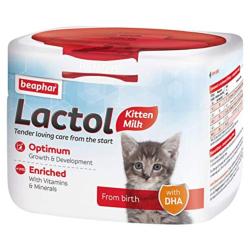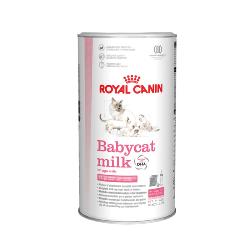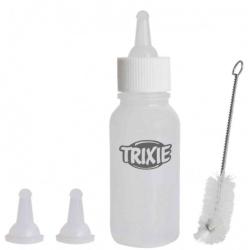Kitten Care Guide Bringing any new pet into your home is an exciting event, and the addition of a kitten to your home is likely to be an incredibly fun and interesting experience, however there are a few things to consider before you make the decision to adopt a kitten!
Firstly, a kitten is a long time commitment, with the lifespan of a domestic cat usually being between 15 and 20 years. With every one of these years, comes a financial commitment, with the first year usually being one of the most expensive as you gather any number of toys, figure out what type of toileting set-up works for you and your cat, and of course have your new pet neutered, microchipped and vaccinated.
Kittens are notoriously mischievous and full of fun, and can be surprisingly time-consuming as you cater to their needs. If you are particularly house-proud or wouldn't take kindly to your sofa being used as a scratching post on occasion, you may wish to consider adopting an adult cat whose behaviour has fully developed and been assessed in a foster home.
Kittens do not stay young for long, so the care you provide for your kitten will help to ensure both their happiness and yours, and set the path for you both to enjoy a lasting companionship.
This page will guide you with advice on how to look after a kitten and adapt your home for your new feline family member. Getting a KittenThe UK and Ireland are experiencing ongoing crises with thousands of kittens born every year to cats whose owners did not have them neutered. It is the many rescue centres who often find themselves picking up the pieces and caring for these unwanted kittens until they are ready to be rehomed and suitable homes can be found.
Throughout 'kitten season' (usually from April until October) many rescue centres are inundated with kittens and will have kittens available for new homes. While you may see individuals selling kittens via online channels like Gumtree or Facebook, we don't recommend obtaining a kitten from these sources, as it often encourages the owners to allow their cats to continue to breed.
Considering that your feline friend could be with you for more than 15 years, personality and health should be placed above colour and appearance, when choosing your new kitten.
Watch how the kittens play and interact so you can get a glimpse into the future character of your new companion. For example, if you have young children, a playful and confident kitten may be the best choice, whereas if you are an older person who leads a quiet life, the calmer kitten may be a better fit. Well socialised kittens will be comfortable with and unafraid of your presence, and should be keen to play with a teaser toy when tempted. When picked up, squirming is completely normal for a young kitten, but biting and hissing may suggest that the kitten is not right for you if you aren't used to socialising less confident animals.
It's best to have a vet check over your kitten within 24 hours of adoption, so you can register the kitten in case of emergency, have them microchipped and begin their vaccinations to protect them from infectious diseases. However, to avoid unpleasant surprises, you can perform a few quick spot checks to ensure there are no obvious health conditions affecting your future friend.
Check the skin and coat for scabs, rashes, bald spots and small black specs of dirt, which could indicate a flea infestation. A healthy kitten's teeth will be white, and the gums pink, and the kittens should be completely weaned onto solid food. The ears should be clean, with no gritty debris. Rear ends should be clean and free from any signs of runny poop. A normal kitten will not feel fat or skinny, the ribs should not be visible but neither should the belly be swollen. Kittens should be at least 8 weeks of age before being removed from their siblings.
Kittens who are taken from their mothers too soon may have trouble grooming themselves, not know how to bury their waste in the litter box or play too rough. A kitten that is removed from its mother too soon may also have trouble adjusting to its new home and you. Growing up with a mother and littermates is an essential part of cat socialization and without this socialization at a young age, the kitten may grow up to be fearful, skittish, or even aggressive. A kitten removed from its mother too soon may also need nutritional supplementation and other veterinary care early on in life.
Adult cats can be territorial and unsure about accepting a new kitten into their space, so if you plan to have two cats in the future it's often easier to adopt two at the same time. Unlike dogs, in which littermate syndrome is a huge issue when taking on two puppies of a similar age, cats and kittens appear unaffected and adopting two shouldn't affect your bond with the kitten.
A pair of kittens can continue to socialise and learn bite inhibition from each other after leaving the litter, which may contribute to friendlier, easier to handle adult cats. With all this considered, only take on as many kittens as you can afford to feed, insure and provide routine veterinary care for. While two kittens will provide great companionship for one another, and double the fun for you, they will also require more of your time and will require access to separate resources (litter trays and food bowls).
 An 8 week old kitten will usually weigh between 600 grams and 900 grams.  All of the baby teeth should be present & the kitten should be eating independently.  The eyes should be their adult colour. All kittens under 8 weeks have blue eyes. Home EnvironmentCats can be successfully, happily and healthily kept as indoor only pets. They can enjoy mental and physical stimulation and fun, without being subjected to the risks that come with allowing your cat to free roam outdoors. Indoor cats also tend to live longer lives, are victims of less attacks by other animals and suffer from fewer parasite infestations.
If you do choose to let your cat explore outside, they should be kept inside until they are at least 6 months of age. After this age, they are less likely to be at risk from predators. Kittens should be neutered, vaccinated, microchipped and wearing a safety release collar and ID tag, before being allowed outside unsupervised.
Many owners choose to build enclosed areas known as catios in their gardens, where their cats can enjoy the outdoors and fresh air, without being subjected to the dangers faced by the outside world.
Before collecting your kitten, set aside a dedicated, secure room. This area should include their food and water bowls, litter tray and bedding. The feeding and drinking area should not be very close to the litter tray, as instinct directs a cat not to eat or drink beside where they toilet in order to avoid contaminated nutrient sources. Kittens should be provided with a room or area in the house that is out of bounds to children, especially as kittens need to sleep for long periods frequently throughout the day. When they are awake, they need short intensive play sessions, while ensuring that they do not become too exhausted.
Kittens and adult cats alike tend to love cosy 'igloo' style beds to relax and sleep in, as the covered area offers a safe retreat and appeals to natural instincts of finding cover for safety. If your home is very busy, you have lots of other pets, or if your kitten is nervous or having difficulty settling in, a cage in which their bed, food and water dishes and litter tray can be placed in will usually help the kitten to get used to their surroundings with much less stress.
Kittens need lots of sleep, they grow so quickly and spend so many of their waking hours playing, so a good quality sleeping area is important for their growth and development. Even adult cats spend an average of 16 hours per day sleeping, so setting up a super sleeping space for your kitten will be appreciated for many years to come.
Most kittens are exceptionally easy to litter train, quickly making the association between an easily accessible digging area and going to the toilet. When introducing your kitten to their litter tray, gently rub their front paws through the clean litter material so they are aware that their litter tray contains the litter.
The litter tray should be kept in a secluded and quiet corner of a room, at a distance from their feeding, sleeping and playing areas. Other animals should not be allowed access to the litter area as this may discourage the kitten from using the tray, and it is important that humans also do not interrupt the kitten when it is using the litter tray. The litter tray must be sufficiently large for the kitten to enter, turn around and dig in without being obstructed.
Introducing unfamiliar cats and kittens should be done very slowly and there is no guarantee that they will peacefully cohabit. Ensure that your adult cat is safely contained within the home when first meeting the kitten - many adult cats will see a kitten in their environment and panic, running away and becoming lost. This process can be helped by providing separate bowls and litter trays in a variety of different places in the home to avoid conflict and competition.
A slow and gradual introduction can make all the difference when introducing a kitten and a dog to each other. However, this is no guarantee of success and some cats and dogs will never get along. If your dog is inclined to chase smaller animals, consult with a behaviourist before taking your kitten home, to ensure your new kitten's safety. Always provide plenty of escape routes for cats from boisterous dogs, such as baby gates and raised platforms.
Kittens are very inquisitive and love to explore, but be aware that there can be hazards around the house which may not pose issues to your other pets but could prove incredibly dangerous to a cheeky kitten. While you must always make sure your cat has a safe retreat where they can hide, it’s important to kitten-proof the house to help keep your kitten safe.
Kittens can, and do, squeeze into the smallest of spaces and have a habit of sleeping in peculiar places. Block off any gaps between cupboards, furniture and kitchen appliances. Screen off open fireplaces and always supervise your kitten if you have an open fire in your home. Keep cupboards, washing machines , tumble driers and toilet lids closed, to avoid the risk of drowning or coming into contact with cleaning chemicals or toxic substances. Ensure that hot liquids are never left unsupervised. Keep all cables and wires securely protected and out of reach.
FoodLike all cats, the domestic cat is a meat eater and, as esteemed predators, they not only eat meat but in fact have become dependent on a meat diet (they are obligate carnivores) and actually cannot thrive or survive without meat in their diet.
The resulting physiological presentation of the development of the domestic cat as a species, is a body without the special enzymes or metabolic pathways to digest and convert nutrients in plants to what they need.
Domestic cats are specialised hunters like the wildcats they are descended from and, as solitary predators, their prey tend to be small mammals and birds. Since the average mouse only contains about 30 kilocalories, cats must hunt, kill and eat around ten mice a day in order to meet their daily energy and nutrient requirements. Therefore, under natural circumstances, cats consume frequent small meals (in the form of prey) throughout both the day and night (when their nocturnal prey are active). In fact, feral cats can spend up to 12 out of every 24 hours looking for and obtaining food.
Being reliant on having meals around an owner's busy schedule means that many cats are fed one or two larger meals today - an unnatural schedule which can lead to behavioural issues and health problems such as obesity. Even if cats are given ad libitum access to food (meaning food is unrestricted and available at all times), which would allow them to eat little and often, their modern lifestyle may lead them to overeat for several reasons.
It is therefore best to divide a cat’s daily food ration into at least three portions, and feed this throughout each day using puzzle feeders and timed feeders. Puzzle feeders are objects which hold food and must be manipulated to release this foo, helping meals to last longer and increasing physical exertion needed to obtain food.
Kittens grow quickly and have much higher energy requirements than their adult counterparts, alongside higher requirements for protein, amino acids, and minerals, as well as for some vitamins. A kitten's diet should consist of at least 30% protein, from good quality animal sources and as part of a complete diet.
In addition to requiring a much higher level of protein in the diet than most other animals, cats also require a number of specific amino acids to be present – these are taurine, arginine, methionine and cysteine. These amino acids are not found in plants – many animals (including dogs and humans) can convert and use other amino acids derived from plants, but cats have lost the ability to synthesise these amino acids, as their natural diet contains them in abundance. Without these amino acids in the diet, cats will simply die.
The feeding of both wet and dry diets have their merits, with the abrasive action of dry food having a positive effect on oral hygiene and wet food having a much higher water content than dry food, and so helping to ensure adequate water intake, especially as cats naturally obtain much of their water intake from their food (meat has a high water content).
Check our selection of dry cat food and wet cat food.
To encourage urinary health, a mixed diet of 50% dry food and 50% wet food is advised, ensuring your cat gets plenty of moisture in their diet alongside the dental benefits provided by dry food. Each cat will have their own preferences regarding preferred textures and flavours of the wet food they enjoy eating, so experiment with different protein types and consistencies such as paté and chunkier diets. Health CareDue to their small body size and immature immune systems, a kitten’s health can deteriorate very quickly, so take them straight to the vets if they are ever injured or seem unwell. Consider taking out a good pet insurance policy to ensure you can afford veterinary treatment should your cat be injured or fall ill unexpectedly, with a lifetime policy covering longterm illnesses being the gold standard.
Kittens should first be vaccinated at eight weeks of age, and they require a second vaccination 4 weeks following the first, in order to protect them against some serious infectious diseases. Even if your kitten is kept indoors, it is recommended that they are vaccinated as they may be at risk of disease from other
animals in the household or infections that have accidentally been transferred in from outside on an owner’s hands, shoes or clothes. Microchipping is widely recognised as the safest and simplest means of permanently identifying your cat. A microchip carries a unique number linked to a database which holds your contact details, allowing you to be quickly traced should they stray and be scanned for a microchip when found.
Neutering (spaying for females and castration for males) can be carried out at four months of age. Neutered cats tend to live longer and healthier lives, and it is the most humane way to stop unwanted pregnancies and minimise the unwanted cat population. Neutering also prevents some cancers and reduces straying, fighting and spraying.
If you are struggling to afford neutering, which usually costs around £40 for males and £50 for females, consider using the £5 neutering scheme run by the Cats Protection League. This offer is open to owners who are receiving state benefits, are on a low income and who are students or pensioners and who live in Northern Ireland. Under the campaign you can get your pet cat neutered for £5 and microchipping is also available at some participating Veterinary Practices. The guidelines for eligibility for neutering assistance apply to one or more of the following; receipt of certain means-tested benefits, low household income, full-time students living away from home, state-only pension and pension credit. Proof of eligibility will be required by the vet in order to participate in the scheme. Under no circumstances should your cat be allowed outside before it has been neutered. Kitten Starter KitBringing home a new kitten is an exciting time, but it can also be a bit overwhelming.
There are so many things you need to do to prepare for your new furry friend, from setting up their space to stocking up on supplies.
That's why we've put together everything you need to take care of your kitten in the form of a checklist.
Here's a closer look at what's included in our kitten starter kit selection:
We're confident that with all our kitten advices, you are ready to welcome your new furry friend! |



